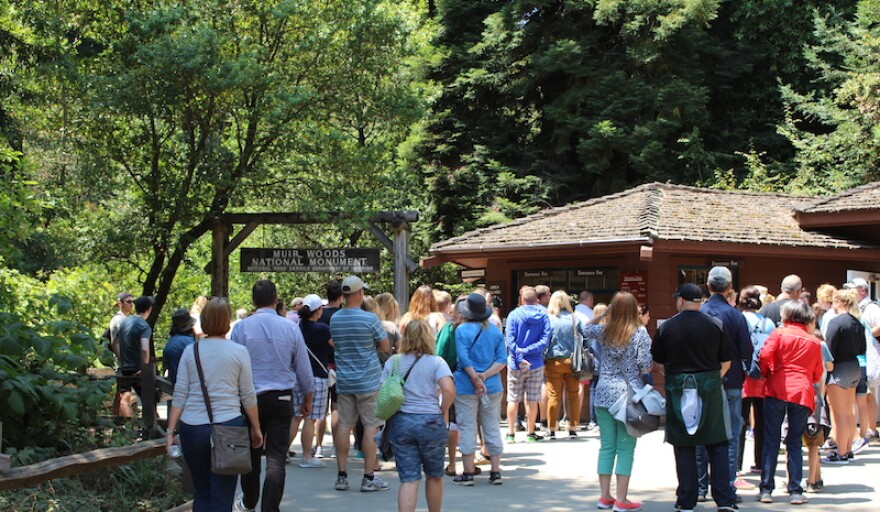One of the most popular parks in the country is just north of the Golden Gate bridge in Marin County. It’s so close to San Francisco that Muir Woods National Monument hosts close to one million visitors a year.
Beyond the welcoming wooden entrance sign, the bucolic sounds of the park abound. Birds chirp, Redwood Creek babbles, and bushy-tailed Sonoma chipmunks scurry about. Visitors crane their necks to get a glimpse of the the tallest living things on earth--the coast redwoods.
That all comes at a cost. Muir Woods is also home to a world-class traffic problem.
Cars, bikers, shuttles, and tour buses clog the windy road to the park. The 11 mile drive to Muir Woods from San Francisco can take as long as 40 minutes, and when visitors arrive they find limited parking. There aren’t enough spaces for every visitor. The situation has prompted park officials to develop a system they hope will accommodate visitors and protect the delicate natural environment they’re coming to see.
It’s 3 pm and Chris Hall and his friends have just finished a 12 mile hike. They still have a ways to go though, because their car’s way down Muir Woods road, parked on the shoulder. Regarding parking, Hall says, “It is a struggle, it’s a lot of people here.” Visitors try to arrive early to find a coveted spot in the lot. Any summer day Muir Woods is overwhelmed by super-sized tour buses backing up and drivers impatiently waiting for one of the 230 official parking spaces. The gravel overflowlot across from the main parking lot is is often full by 9:00 am.
Park ranger Aimee Snider is used to seeing frustrated visitors waiting for a spot. She remarks, “Sometimes in the parking lot things get a little tense. People get in little tiffs and arguments about things.”
Mia Monroe, the liaison between Marin County and the National Park Service, is part of the team trying to solve the parking problem here. She knows it well because she spent 35 years as a park ranger at Muir Woods.
The parking situation may be annoying for people, but Monroe says that for the trees and animals that inhabit the park, it’s life-threatening. The animals most at risk are threatened species like steelhead trout, and endangered species such as silver salmon and red-legged frogs.
Park officials are making changes to protect the natural environment. In the short term they’ve eliminated 300 parking spaces to reduce erosion at Redwood Creek, and preserve the flora and fauna that call the park home.
They’re also counting on increasing the number of visitors who use their shuttle system. Currently, about 30% of Muir Woods visitors catch shuttle buses miles from the park at three different stops in southern Marin. At $5.00 for round trip fare, it’s more economical than taking a taxi or Uber or Lyft in, but there are delays. The lines are long, and each of the shuttles can only transport 40 people.
Monroe says they’re counting on a long-term solution: reservations to visit the park. She predicts, “Those busy, outrageously crowded days are going to be a thing of the past.”
That’s a big promise. She says no more than 4,500 people will be able to visit Muir Woods a day. Currently, on peak weekends and holidays, the park may see more than 6,000 visitors.
Monroe says they hope the reservation system will actually spread visitors out throughout the year, but they’re willing to have fewer visitors if that protects the natural environment. Park Ranger Aimee Snider says a reservation system may be difficult at first but “could probably work well eventually because Alcatraz has one.”
The project will roll out in stages, starting in fall, 2017. In the meantime, some visitors have to improvise.
On a busy Sunday, two Dutch women, Lorian Boosten and Isabel Barnhoon, hold their thumbs out by the side of the road. They took an Uber here, but can’t get cell service to get a ride a back out now. When a van pulls up and stops in front of them, Lorian and Isabel plead, “Can we hop in?” The driver smiles and welcomes them in, as they shut the door and drive down Muir Woods road and head back to San Francisco.


